Circulation Issues, MFA Alumni Photography Duo Exhibition
Work by Department of Art MFA Alumni Hope Mora (2020) and Jeremiah Ariaz (2005).
Closing Reception: Tuesday October 29, 2024, 5-7:30PM, during “Art in the Open”
Exhibition open: October 1 – November 9, 2024
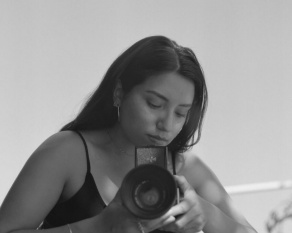
Hope Mora
Hope Mora is a visual artist currently splitting her time between Houston and West Texas. Her work is an ongoing exploration of how the dynamic between hard labor and resilience is sustained within communities, specifically in her hometown Pecos, Texas. Mora’s research looks into working life, regional culture, economy, and ideas of home. She documents how communities joyfully celebrate their lives through family, food, music, dance, and fashion using photography, video, sound, and text.
Mora's work has been recognized and commissioned by The New Yorker, Vogue, The Texas Tribune, and more. She has exhibited her work in gallery and public space exhibitions including NXTHVN, Center for the Study of the Southwest, Mexic-Arte Museum, Public Art San Antonio, Squeaky Wheel Film & Media Art Center, and The Buffalo Institute for Contemporary Art (BICA), among others.
Mora’s work is also being shown in 2024 at the Houston Center for Photography, for the show Pecos, Oct. 24-Nov. 24, 2024.
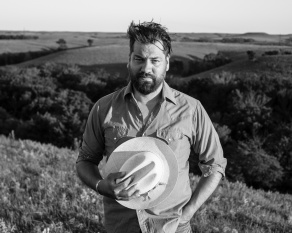
Jeremiah Ariaz
Jeremiah Ariaz received his BFA from the Kansas City Art Institute and MFA from the State University of New York at Buffalo. His photographs examine the constructs of American identity within personal, community, and political contexts.
Ariaz is a recipient of numerous awards and grants, including an ATLAS grant, the Michael P. Smith Award for Documentary Photography from the Louisiana Endowment for the Humanities, the 2018 South Arts Finalist Prize and he was named the 2018 Louisiana State Fellow. His photographs have been featured in publications including Oxford American, The Paris Review and The New York Times. His writing has been published in the Symphony in the Flint Hills Field Journal, Southern Cultures and The Washington Post.
His photographs have been exhibited in solo and group exhibitions internationally, including venues such as the Ogden Museum of Southern Art (New Orleans, LA), Lawndale Art Center (Houston, TX), Des Moines Art Center (Des Moines, IA), Columbus Museum of Art (Columbus, GA), Museum of Contemporary Art (Jacksonville, FL), the Center for Documentary Studies at Duke University (Durham, NC), Zeitgeist Gallery (Nashville, TN), Marianna Kistler Beach Museum of Art (Manhattan, KS), the Acadiana Center For The Arts (Lafayette, LA), Vanderbilt University (Nashville, TN), B Gallery (Rome, Italy), Photographic Gallery (San Miguel de Allende, Mexico) The Foreign Correspondents’ Club (Hong Kong, China).
A monograph of his photographs, Louisiana Trail Riders (2018) is available from UL Press. His most recent publication, The Kansas Mirror: The Fourth Estate in the Heart of America (2023) features newspaper offices across his home state.
He has been a professor of art at Louisiana State University since 2006.
Circulation Issues is a duo photography exhibition of Department of Art MFA Alumni Hope Mora (2020) and Jeremiah Ariaz (2005). Mora’s work features highlights from her documentary photography series “Pecos”, including various faces and places in Pecos, Texas, her hometown. Likewise, Ariaz captures smalltown America, with an understated appreciation for the seemingly banal but vital. But in Ariaz’s case, there is a specifically pointed investigation going on. Where Mora’s series in Circulation Issues is a documentary photography pursuit, with subjects deeply personal, Ariaz’s series is a meta journey in the realm of what documentary photography and journalism mean to folks in Kansas, and maybe to us all, within the context of current societal conditions. Ariaz’s exploration of small-town news begs questions of authorial voice, labor, economics of scale, and the complexities of power that rule “the fourth estate”. In many ways Mora’s work does the same, but while hers creates an archive to behold and perhaps discern, Ariaz’s slates a platform to absorb and build upon. Both look to decipher communities and human conditions, and guests are invited to participate in these inquiries.
Mora’s “Pecos” subjects are intimately connected with her, through their social and familiar associations, and the gaze she casts upon them is one of honor, respect, and admiration, for the resiliency and beauty of lives in this small town. Mora beautifully captures Pecos’ “slice of life”, and the subjects being viewed exude a quiet confidence and trust, product of the noble treatment that Mora attends to them with. From the rodeo to park pavilion, tire shop or food truck workplace to trailer park, these subjects pierce through time and distance, to tell the viewer stories of a place bursting with life, in a way to be proud of.
In his “Kansas Mirror” series, Ariaz has mined the state of Kansas for the sites of small-town newspapers, probing for the values and qualities of these small business. In the pursuit of honest and equitable news, these newspapers (that is to say, the people that operate them) do what they can, to keep the lights on, and new news rolling. From the entrance point of the gallery, visitors will see contrasting parallel walls of grids of newspaper office facades from this series. The differences in the two demonstrate ghostly absences from each grid, as one is offices that are still operational, and the other is ones that have had to “shutter” their doors, paired with writing on the wall: “Sorry, we’re closed”. Ariaz’s “Kansas Mirror”, newspaper-style artist publication, is incorporated in two ways to the installation. The more evident, is how it is hung sheet by sheet upon the central wall, to emphasize the notability of its messages, and sanctify the subjects, just as the photo enlargements around the rest of the gallery do for Ariaz and Mora’s faces/places subjects that are featured.
Visitors can take a seat and read printed materials collaged on an interior wall, and set upon a table between two chairs, which further contextualizes Mora and Ariaz’s series. Ariaz’s “Kansas Mirror” in its newspaper, natural folded style, is among the works on the table, and this reading area is modelled after Ariaz’s capture of a table at the The Morning Sun newspaper office in Pittsburg, KS, 2022, which is depicted with an enlargement along the same wall. Among the printed materials of the reading area are also the paper of Mora’s MFA thesis, and her “Pecos” photographs book. It is from this series that her displayed works have been selected, four and a half years passed, since they were hindered from meeting gallery walls, due to pandemic shutdowns. Mora’s subjects are now elevated to the large-scale portraiture, meanwhile beside these works and the reading area, an enlarged page 6, from the Pecos Enterprise, April 30, 2020, shows the “Love Letter to Pecos” spread. That spread is a “guest writer” feature by Mora, which her hometown newspaper was able to bring to its primary audience, the community members of that place, in the year of origin.
Many of the works in this exhibition have proudly captured subjects, that stare back at the lens, which freezes a frame of their livelihood and/or lifestyle. Other photographs are stark interior or exterior scene-scapes, where the absence of the assumed people whose lives are contained in these spaces, challenge the viewer to insert personal stories into the settings. In both cases, Mora and Ariaz’s works illicit a conundrum of visibility and erasure, a present moment, that quickly slides into the past. Problematizing the mainstream, by giving us deeply intriguing and intricate smaller streams, these artists demonstrate the value and beauty to be captured in local networks of communication and life, that are so tender, in their tightness.
Both artists have personal websites, where expanded collections of these and other photography series of their work, can be viewed. Please visit for more info:
Admission is free and open to the public. Open Monday-Saturday, 10AM-7PM.
Parking is free in most lots in campus after 3PM. Check signs. If a parking permit is needed, request in advance to whitneyk@buffalo.edu, or visit the Art Office, 202 Center for the Arts. Gallery hours are subject to change. Contact in advance if a confirmed appointment is desired.
Light refreshments will be provided at the closing reception on 10/29, 5-7:30PM.
This exhibition has been organized by Art Resource Manager Whitney Kehl, with assistance from the exhibiting artists, Hope Mora and Jeremiah Ariaz, UB Art Faculty John Opera, and MFA Candidates Meagan Killian, Eilis Regan, and Teju Abiola.
The Department of Art instituted an alumni art series in the Fall of 2023. Beginning that year with large sculptural and painted works by 2010 MFA Alumnus Fredrick Wright Jones, the series continues, with the Circulation Issues.
This exhibition series is organized by the Department of Art Gallery Committee, co-chaired by Professor Joan Linder, and Art Resource Manager Whitney Kehl. Suggestions for future iterations of the alumni exhibition series may be submitted to the Department’s Gallery Committee, by writing to the Art Resource Manager.
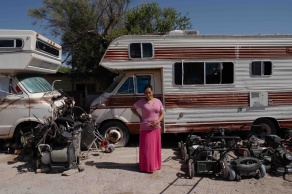
Hope Mora, "Far Away From Here"
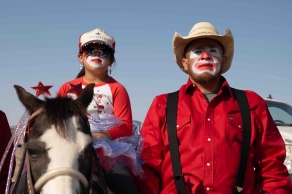
Hope Mora, "American Beauty"
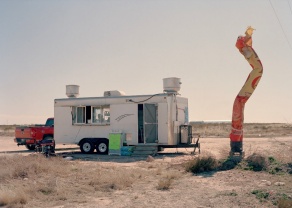
Hope Mora, "Texas BBQ Y Mas"
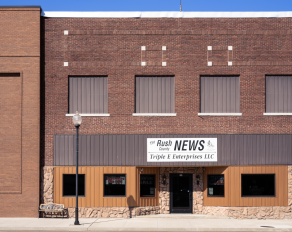
Jeremiah Ariaz, "The Rush County News", La Crosse, KS, 2022
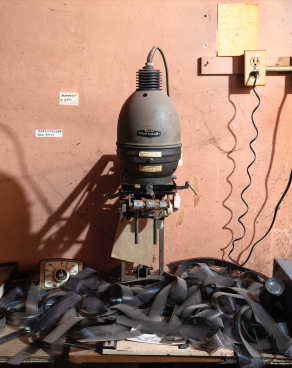
Jeremiah Ariaz, "Darkroom", The Western Star, Coldwater, KS, 2022

Pecos, Texas has for most of its life been a place in-between here and there. It is flat, hot, and dusty with little geological dimension save for the scrub brush that dots the endless horizon. The much-mythologized Pecos River cuts through the windswept plains east of town. Follow that river and the Texas/Mexico border is just a few hours south.
Yet unlike many of the rural towns that have faded away in an ever-increasing urbanized age, Pecos sits on the Permian Basin—a massive geological formation stretching across parts of West Texas and Eastern New Mexico that is exceedingly rich with oil and gas.
Pecos, ostensibly in the middle of nowhere, is in fact part of the epicenter of the global energy market. The town and its people provide the labor and support structures for this multi-billion dollar oil industry.
In Hope Mora’s Pecos Eagles, we see the many layers of this small but complex geography, mostly through affirmative portraits of the people that live there and make up the community: a young girl dressed in an Elsa costume stands in the middle of a rodeo ring; two teens wearing Pecos Eagles t-shirts stand firm, gazing back at us, as a pink West Texas sunset drifts away on the horizon; a woman with turquoise boots stands in the late afternoon sun against her dump truck, likely used for hauling kaliche or water to the oil fields.
The Fourth Estate features newspaper offices across my home state of Kansas (USA). The photographs celebrate the civic function, labor, and technology at the heart of local journalism, while also documenting an industry under threat, as are the ideals of democracy the industry upholds.
The U.S. is losing an average of two newspapers a week; a quarter of the nation’s papers have closed in the last 15 years. Kansas lies at the precipice of the nation’s news desert, at its most arid across the Western half of the country.
Since 2022 I have photographed over 100 newspaper offices. These images are both an ode and an elegy, a collective portrait of my home state in the geographic center of the nation, and a representation of community newspapers across the United States.
An essay Ariaz wrote, focusing on one Kansas newspaper for a "Special Edition” of the "Kansas Mirror: The Fourth Estate in the Heart of America": http://www.jeremiahariaz.com/western-star
The office of the Marion County Record, (photographed in the series) was raided by police in 2023. It became the center of international coverage.
https://www.nytimes.com/2023/08/19/business/media/kansas-newspaper-marion-county-record.html
https://www.nytimes.com/2023/08/13/business/media/kansas-marion-newspaper-police-raid.html
Ariaz authored an Opinion Piece in the Washington Post about the Record in the days after the raid.:
[Review] The Fourth Estate at Zeitgeist Gallery, Nashville
BY JOE NOLAN OCTOBER 17, 2024
https://burnaway.org/daily/the-fourth-estate-at-zeitgeist-gallery-nashville/